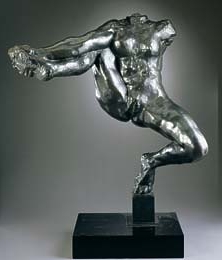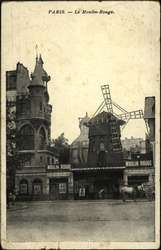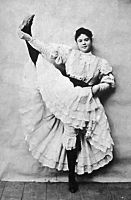|
 'Iris, messenger of Gods' exists in two versions: the
larger version is headless and lacking the left arm, the smaller one, a modification without left arm and left foot, is also known as
'Flying Figure'. In 1890, Rodin intented this figure to be integrated in the second outline for the
'Monument to Victor Hugo', after the first model had been rejected in
1890. According to Grappe the figure was to personify Glory, although
traditionally, Iris is known as the messenger of the Olympic deities, the
female counterpart of wing-heeled Hermes. 'Iris, messenger of Gods' exists in two versions: the
larger version is headless and lacking the left arm, the smaller one, a modification without left arm and left foot, is also known as
'Flying Figure'. In 1890, Rodin intented this figure to be integrated in the second outline for the
'Monument to Victor Hugo', after the first model had been rejected in
1890. According to Grappe the figure was to personify Glory, although
traditionally, Iris is known as the messenger of the Olympic deities, the
female counterpart of wing-heeled Hermes.
The title attribted to the work may have been a manoevre
to support its acceptance with Committee officials, who must have felt
provoked by the combination of the national hero and poet Hugo with a
headless sculpture centering around the female genitals - Rodin's
not-too-subtle reaction to their rejection of his original concept. As an
additional interpretation, Levkoff suggests Rodin may have associated the
arched pose with the arc-en-ciel, the rainbow associated the Greek
goddess Iris.
As he did with many sculptures, Rodin separated 'Iris' from the group and
varied
the orientation of the fragment, till he found the pose with the highest
expressive momentum. The tension in her acrobatic body and her bare, exposed
crotch add to the powerful erotic charge of this female figure.
The audacity of the pose indicates Rodin had
entered a new stage of dealing with the female nude. Like in his drawings,
he has by now abandoned the pessimism of his former work, still
dominated by the ambivalence between passion and its denial. The erotic
drawings Rodin produced in large numbers during the last two decades of
his life show women in lying, standing and kneeling postures, spreading their tighs and showing their uncovered sex to the spectator.
 'Iris'
is a monument to Rodin's glowing erotomania - at the same time, it
demonstrates his strong interest in new and unconventional forms of dance.
Tancock mentions an article about the chahut dancer Grille dŽEgout
which appeared in Gil Blas in May 1891 and was kept in Rodin's
files.
This form of dance, which was later named Can-Can, triggered a wave of 'dirty
dancing' in the Paris dance halls of the 1830's. The chahut dancers
threw their legs high up in the air, so that the upper body was catapulted
backwards.
Heinrich
Heine - 'Iris'
is a monument to Rodin's glowing erotomania - at the same time, it
demonstrates his strong interest in new and unconventional forms of dance.
Tancock mentions an article about the chahut dancer Grille dŽEgout
which appeared in Gil Blas in May 1891 and was kept in Rodin's
files.
This form of dance, which was later named Can-Can, triggered a wave of 'dirty
dancing' in the Paris dance halls of the 1830's. The chahut dancers
threw their legs high up in the air, so that the upper body was catapulted
backwards.
Heinrich
Heine - correspondent for the Augsburger Zeitung in the 1840's - described
it as the 'dance of paganism', a 'satanic ruction'. Later, this pair dance was stylized into the
famous revue dance show presented by the Montmartre cabarets. On 5 October 1889, the famous Moulin
Rouge opened its doors, announcing professional dancers described as
"a host of young girls who are there to demonstrate the heavenly
Parisian Chahut dance as its
traditional reputation demands... with a physical elasticity as they do the
splits, which promises just as much flexibility in their morals."
Like Lili Jambe-en-lŽair depicted here, Grille dŽEgout (a nickname based on the space between her teeth) was one
of the vedettes of the Moulin Rouge club. The formal similarity of
Lili's pose to the shape of Rodin's sculpture is obvious and
striking. correspondent for the Augsburger Zeitung in the 1840's - described
it as the 'dance of paganism', a 'satanic ruction'. Later, this pair dance was stylized into the
famous revue dance show presented by the Montmartre cabarets. On 5 October 1889, the famous Moulin
Rouge opened its doors, announcing professional dancers described as
"a host of young girls who are there to demonstrate the heavenly
Parisian Chahut dance as its
traditional reputation demands... with a physical elasticity as they do the
splits, which promises just as much flexibility in their morals."
Like Lili Jambe-en-lŽair depicted here, Grille dŽEgout (a nickname based on the space between her teeth) was one
of the vedettes of the Moulin Rouge club. The formal similarity of
Lili's pose to the shape of Rodin's sculpture is obvious and
striking.
In later years, Rodin continued to pursue his interest
in dance as performed by Loïe Fuller and Isodora Duncan, the Japanese
actor Hanako and the Russian dancer
Nijnski, whom Rodin portrayed in 1912
- also with one leg pulled up. In the period 1910- 1915, he created a series of small
dance studies, containing the essence of both bold and gracious movement.
|
 'Iris, messenger of Gods' exists in two versions: the
larger version is headless and lacking the left arm, the smaller one, a modification without left arm and left foot, is also known as
'Flying Figure'. In 1890, Rodin intented this figure to be integrated in the second outline for the
'Iris, messenger of Gods' exists in two versions: the
larger version is headless and lacking the left arm, the smaller one, a modification without left arm and left foot, is also known as
'Flying Figure'. In 1890, Rodin intented this figure to be integrated in the second outline for the

